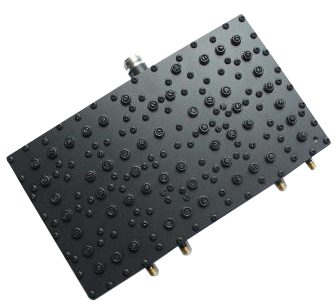Ku-Band Power Divider
12-18GHz 2-way Ku-Band Power Divider
Our Ku-Band power divider is used in many satellite monitoring and test equipment and in many communication systems for the defense industry. They are also used for combining powers in power amplifiers.
Built upon Wilkinson power divider theory, they have low insertion loss, and exhibit high isolation between ports. Amplitude and phase balance performance is excellent, making them our Ku-Band power divider a preferred choice as a power combiner.
A small sample of our Ku-Band power divider can be found in the table below.
We also have wideband power divider as well as standard power dividers.
Contact us with your enquiry on power divider today.
| Part Number | Splitter ways | Operating Frequency | Description |
|---|---|---|---|
| APS-2W-12G-18G-01 | 2 way | 12 -18 GHz | 12-18GHz 2 way power divider, SMA-F, Ku-band |
| APS-3W-12G-18G-01 | 3 way | 12 -18 GHz | 12-18GHz 3 way power divider, SMA-F, Ku-band |
| APS-4W-12G-18G-01 | 4 way | 12 -18 GHz | 12-18GHz 4 way power divider, SMA-F, Ku-band |
| APS8W-12G-18G-01 | 8 way | 12 -18 GHz | 12-18GHz 8 way power divider, SMA-F, Ku-band |
The Crucial Roles Performed By Ku-band Power Dividers
In radiofrequency and communications technology, “power dividers” play major roles. This device has been applied to various devices to distribute power to a number of outputs. In general, a power divider has a single designated input port and more than one output port, all ports are theoretically matched, and the output ports are isolated from each another. Now how does this device help the satellites and communications devices that operate in different bands, such as the Ku-band? Let’s look at the basic features of Ku-band power dividers.
The Different Types Of Power Dividers
In general, power dividers are “passive components that are used for splitting a signal into two or more identical output signals”, and they’re used to combine two or multiple signals into one output signal as well. Before we delve straight into a Ku-band power divider, let’s first take a look at the different types of power dividers.
A “reactive” power divider is built using a wide array of techniques in a wide range of frequencies. This class of power-dividers are divided into two design types – Lumped-Element and Distributed-Element. A Lumped-Element design is for low-frequency applications, usually from a few kilohertz to around 3 gigahertz maximum.
Reactive power dividers can be constructed without isolation among few outputs ports, although in general, isolation is a very crucial characteristic of this type of power dividers.
A “resistive” power divider is constructed using resistors for matching to the “Zo”, or system impedance at each individual port. This type of power divider does not exhibit isolation between outputs, and this divider’s frequency band is also the widest from DC to any frequency higher.
What’s The Ku-Band?
The “Kurtz-under” band, or the Ku-band, is mainly utilized for satellite communications, especially for editing and broadcasting satellite television. The band is divided into different segments that are broken down into geographical regions, as determined by the ITU, or International Telecommunication Union.
The Ku-band’s portion in the electromagnetic spectrum in the microwave range of frequencies is from the 11.7 gigahertz (GHz) to 12.7 GHz, which are downlink frequencies, and from 14 GHz to 14.5 GHz, which are uplink frequencies.
However, satellite and communications networks operating under the Ku-band are more prone to what’s called as rain and snow “fade”, especially in countries or regions where there’s excess rain or snow accumulation.
What Are The Functions Of Ku-Band Power Dividers?
Power dividers are utilized in a wide assortment of applications, and they can satisfy any technical requirement wherein a signal needs to be distributed or combined.
For starters, power dividers are used in various applications such as transmission line fault testing, power combining, source leveling, ratio measurements, power splitting, as well as in signal processing applications which require minimal insertion loss and high port isolation.
These devices are also utilized in aerospace and defense, broadband CATV and wireline communications applications, and are available in a wide array of connector and surface-mount packages. Ku-band power dividers help provide minimal insertion loss, while delivering high isolation between the output ports, with amazing phase and amplitude balance.

